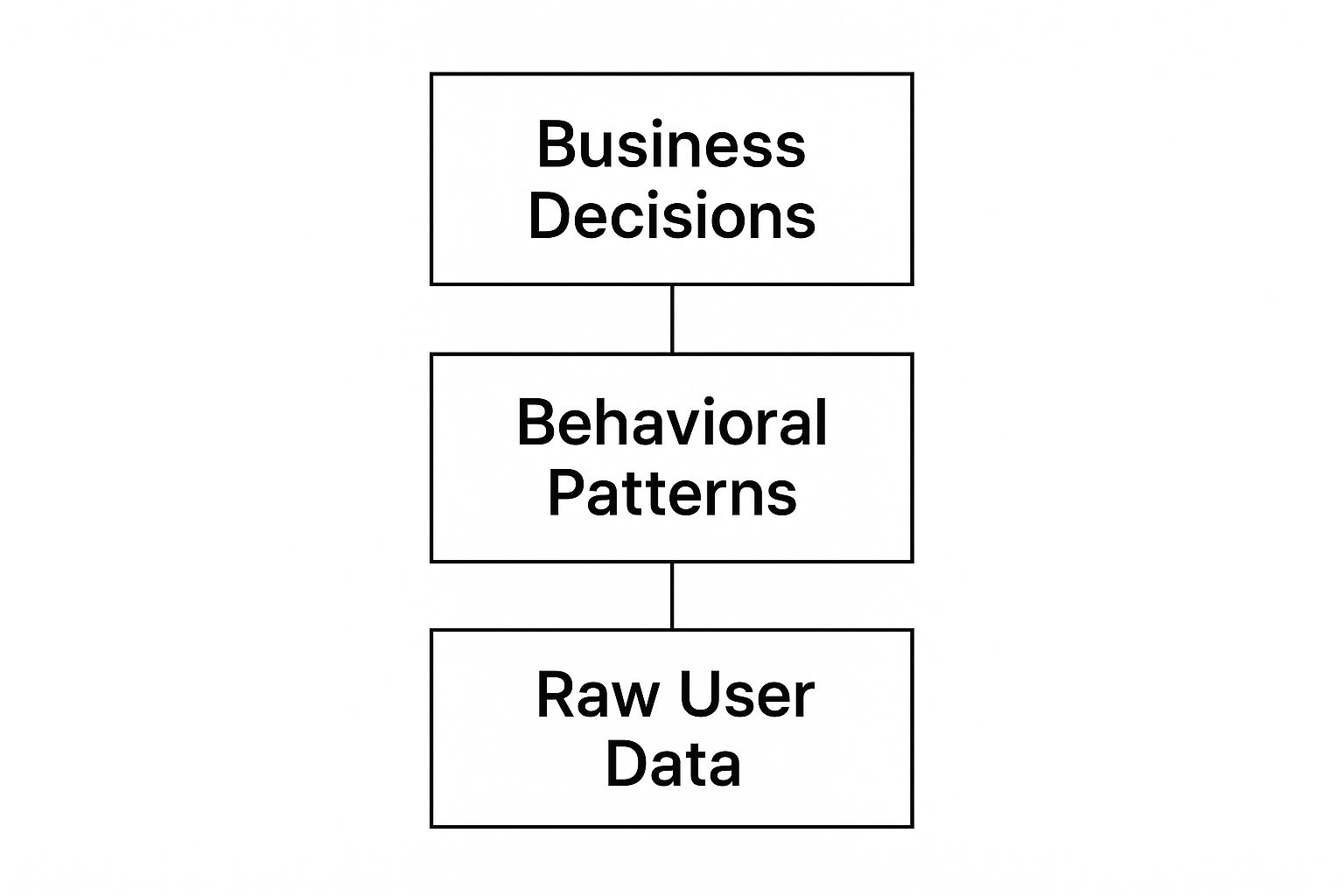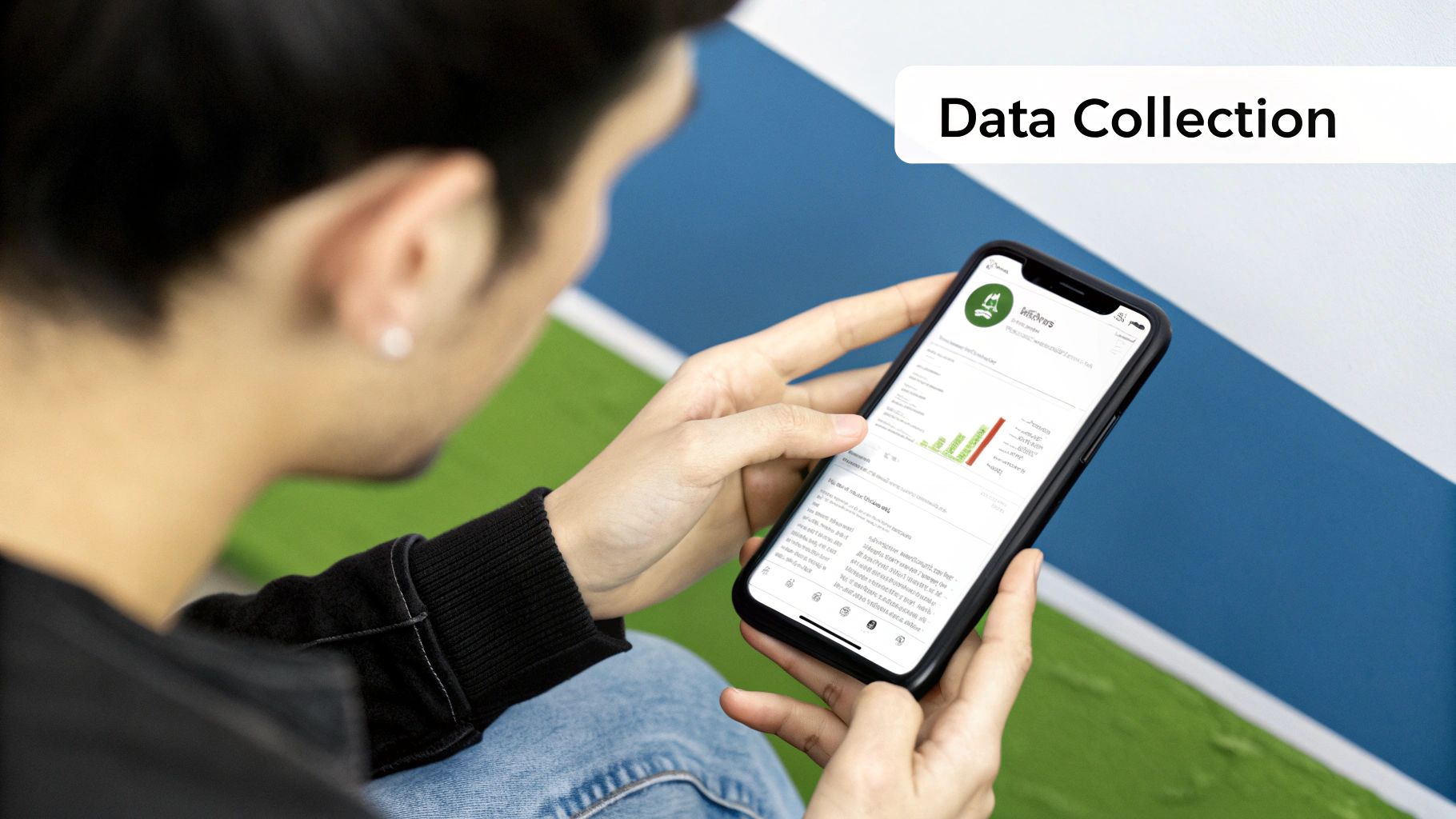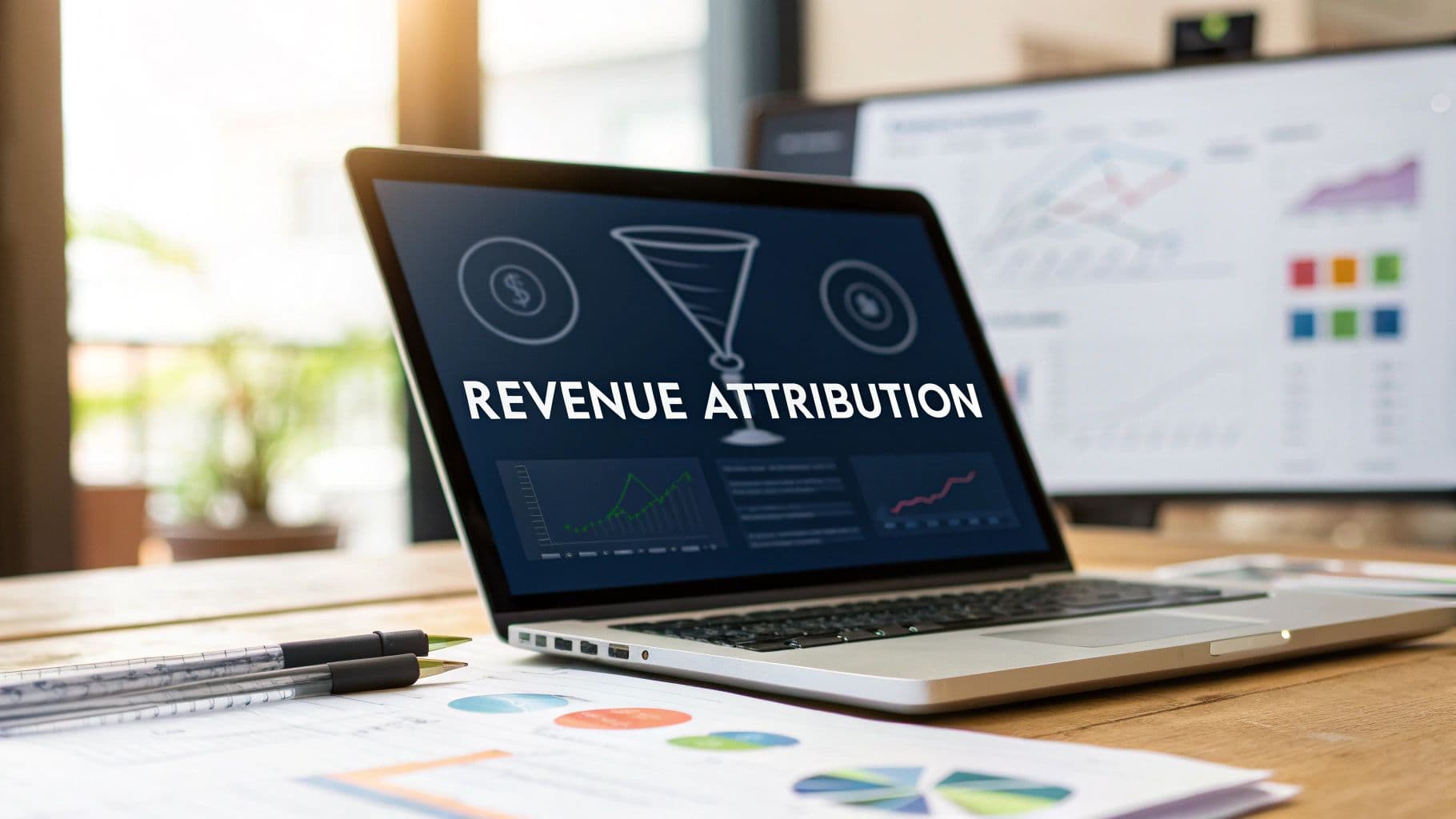What Is Behavioral Analytics? Unlock User Insights Today
Learn what is behavioral analytics, how it reveals user intent, and drives business growth and cybersecurity. Discover key concepts and real-world examples.

So, what exactly is behavioral analytics? At its core, it’s about piecing together the story of why your users do what they do.
Think of it this way: traditional analytics tells you what happened. You can see you got 1,000 new sign-ups or that a specific page has a high bounce rate. That’s the "what." Behavioral analytics digs deeper to show you the "why"—it reveals the complete sequence of actions a user took, giving you the context behind those numbers.
Going Beyond Clicks to Understand User Intent

Imagine you're watching a game replay instead of just looking at the final box score. The box score gives you the stats—who scored, how many points. The replay shows you the plays, the strategy, the fumbles, and the moments that truly decided the game.
That’s precisely what behavioral analytics does for your product. It moves beyond isolated metrics like page views and connects the dots between every click, scroll, and pause. You don’t just see that a user abandoned their cart; you see the exact journey they took, the features they interacted with, and the likely friction point that made them leave.
From Static Data to Dynamic Stories
This shift from static numbers to dynamic stories is a game-changer. It helps you ask much smarter questions about your product and users.
Instead of just knowing how many people visited, you can start asking:
- What specific features do our power users engage with right before they decide to upgrade their plan?
- Is there a common sequence of actions that signals a user is frustrated and about to churn?
- Where exactly in our onboarding flow do new users get stuck and give up?
To put the difference into perspective, here’s a quick comparison of the two approaches.
Traditional Analytics vs Behavioral Analytics
| Aspect | Traditional Analytics | Behavioral Analytics |
|---|---|---|
| Primary Focus | What happened? (e.g., page views, sessions) | Why did it happen? (e.g., user paths, friction) |
| Data Type | Aggregated, anonymous data | Individual user event streams |
| Core Question | "How many?" | "What leads to...?" |
| Key Insights | Website performance metrics | User intent and motivation |
| Time Frame | A snapshot in time | A story over time |
As you can see, one gives you a high-level overview, while the other provides the granular, contextual insights needed to make meaningful improvements.
Here at SigOS, we live and breathe this stuff. We turn these complex user stories into clear, measurable business outcomes. Understanding the "why" behind every click lets us help you pinpoint the exact issues costing you money and, more importantly, find the hidden opportunities that will drive real growth.
The Building Blocks of Behavioral Analytics
To really get what behavioral analytics is all about, you need to look at its core components. Think of them like the essential ingredients in a recipe—each is distinct, but when you combine them, you create something powerful. By breaking down how user data is gathered, sorted, and studied, we can start to see the whole picture.
The entire process kicks off with raw user data. This data is then organized into recognizable patterns, which ultimately helps you make much smarter business decisions. This infographic gives a great high-level view of how simple actions are turned into strategic insights.

What this visual really drives home is a critical flow: individual clicks and scrolls don't mean much on their own. They only become valuable when they’re structured into patterns that inform high-level strategy. It’s all about finding the signal in the noise.
Tracking Every Action with Events
The absolute bedrock of behavioral analytics is event tracking. An event is just any specific, measurable action a person takes on your website or inside your product. It’s the digital version of watching every single move a shopper makes in a physical store.
These aren't just simple page views. We're talking about tiny interactions that tell you what someone is trying to do.
**button_click**: When someone clicks "Add to Cart" or "Request a Demo."**video_play**: When a user hits play on an onboarding tutorial.**feature_used**: When someone actually engages with a specific tool in your software.
Tracking these events gives you the raw material you need for every other type of analysis.
Grouping Users with Segmentation
Once you have a steady stream of events coming in, the next logical step is user segmentation. This is just the practice of grouping users into different audiences based on what they do or who they are. It’s kind of like sorting books in a library by genre—it helps you understand each category a lot better.
For instance, you might create segments like:
- Power Users: The folks who log in every day and use your most advanced features.
- New Sign-ups: Users who are in their first week and are still just poking around.
- Cart Abandoners: Visitors who put an item in their cart but bailed before buying.
Mapping Journeys with Funnel Analysis
Finally, we have funnel analysis, which maps out the exact steps users take to reach a specific goal. This visualizes their journey, clearly showing you where people are dropping off. Think of it as following a trail of breadcrumbs to see exactly where people are getting lost.
A classic e-commerce funnel, for example, might track the path from someone viewing a product to completing a purchase. By looking at each step, you can pinpoint the friction points—like a confusing checkout page that causes a 40% drop-off—and make targeted fixes.
Why Behavioral Analytics Is a Strategic Asset

Let's be clear: understanding user behavior isn't just an interesting data exercise. It's a genuine strategic advantage that has a direct impact on your bottom line. Instead of scrambling to fix problems after they’ve already hurt your business, this approach lets you get ahead of the curve with smart, proactive decisions.
By mapping out the entire user journey, you can see exactly where people get frustrated or confused. It turns customer experience from a guessing game into a precise science, letting you smooth out the small bumps in the road before they become reasons for customers to leave.
Drive Smarter Product Development
Behavioral analytics essentially hands your product team a treasure map, showing them how features are actually used in the real world. It gives you direct answers to the questions that should be driving your development roadmap.
- Which features are your power users obsessed with? This is where you double down and invest your resources.
- Which ones are gathering dust? Knowing this helps you simplify the product and cut down on engineering waste.
- Where are new users getting stuck during onboarding? This is your golden opportunity to improve their first impression and hook them for the long haul.
Focusing on real usage ensures you're building a product people don't just need, but one they genuinely enjoy using. When you align your development with how people actually behave, you also boost the crucial user retention metrics that underpin sustainable growth.
Maximize Marketing ROI
This deep user insight also makes your marketing far more effective. Once you know what users are doing, you can stop relying on broad demographic buckets and start creating highly relevant campaigns based on specific actions and interests.
The market's explosive growth tells the same story. Valued at $4.13 billion, the global behavior analytics market is on track to grow at a compound annual growth rate (CAGR) of 26.5% through 2030. This isn't just a trend; it's a fundamental shift in how business is done. The companies that truly understand user behavior are the ones that are going to win.
Putting Behavioral Analytics into Practice
Theory is great, but what does behavioral analytics actually look like on the ground? Its real power comes to light when you see how companies use it to solve expensive, nagging problems by connecting what people do with the results the business gets.
Let's take a look at a classic e-commerce headache: cart abandonment. By mapping the user's journey click-by-click, a retailer can see the exact moment a shopper gets cold feet. Was it a surprise shipping fee that popped up at the last second? A clunky form that was too hard to fill out? Or maybe they just got distracted?
This is the key. You move from a fuzzy problem like "people aren't finishing their purchases" to a sharp, actionable strategy. It's the difference between knowing that people leave and understanding why—and having a plan to bring them back.
Optimizing the SaaS User Journey
These same ideas are gold for a SaaS company trying to keep its customers. Imagine a software business bleeding new users and not knowing why. Instead of just guessing, they can use behavioral analytics to get a clear picture of the entire onboarding experience.
This kind of analysis almost always uncovers game-changing insights:
- Feature Adoption Trends: They can see which tools new users gravitate toward immediately and which ones they never touch.
- Drop-Off Points: The data shines a spotlight on the exact steps in the setup process where people get stuck and just quit.
- 'Aha!' Moments: They can pinpoint the sequence of actions that highly-retained customers take in their first few days.
With this knowledge, the company can redesign its onboarding to actively guide new users toward those "aha!" moments. This isn't guesswork; it's a data-backed plan to slash churn by making sure customers feel the product's value from day one. To take this a step further, you can explore how to use cohort analysis to understand user retention over different timeframes.
Personalizing Content for Engagement
Now, think about a large media company. Their business lives and dies on keeping eyeballs on their content. They use behavioral analytics to build recommendation engines that don't just guess what you'll like—they know.
The system analyzes everything: which articles you read to the end, what videos you share, and the topics you search for. It then uses those patterns to predict what you’ll want to see next. This creates a deeply personal experience that keeps you clicking, which in turn boosts session times, ad revenue, and reader loyalty. It's how they turn a casual browser into a devoted fan.
Enhancing Cybersecurity with Behavioral Analytics
Behavioral analytics isn't just for fine-tuning products or marketing campaigns; it's also a game-changer for modern cybersecurity. This specific application, often called User and Entity Behavior Analytics (UEBA), completely flips the script on security, moving it from a reactive "wait-and-see" model to a proactive, predictive one. It's all about understanding how users and systems normally act.
Think of it like an experienced security guard at an office building. A rookie might just check IDs at the door, but the veteran guard knows the rhythms of the place. They know who comes in early, which teams access certain floors, and who always leaves late on a Tuesday. So, if an employee suddenly tries to access the server room at 3 a.m., that guard’s intuition kicks in. That’s not normal. Something's off.
Spotting Threats That Hide in Plain Sight
UEBA tools work on that exact same principle. They quietly observe and analyze massive streams of data from user accounts, servers, and network devices to build a detailed picture of "normal" day-to-day activity. This baseline is what makes them so good at catching the tricky, sophisticated threats that older, rule-based security systems often miss entirely.
What kind of threats are we talking about?
- Insider Threats: Imagine a disgruntled employee slowly siphoning off sensitive company files. UEBA can spot this unusual data access pattern over time.
- Compromised Accounts: A hacker might steal someone's login credentials, but their mouse movements, typing speed, and system access patterns will be subtly different from the real user's.
- Privilege Escalation: This is when a user account suddenly tries to access systems or data far beyond its typical permissions, a classic sign of an attack in progress.
This is where UEBA really shines—by piecing together small, seemingly unrelated events to uncover a larger threat.

As the image shows, the system pulls data from all over the network to pinpoint high-risk anomalies, flagging them for security teams so they can focus on what actually matters instead of chasing down thousands of false alarms.
The sharp increase in these kinds of internal and credential-based threats is driving huge growth in this space. The behavioral analytics market, recently valued at 1.5 billion, is expected to skyrocket to ****20.6 billion by 2035. Why? Because it’s one of the few methods that can reliably catch attacks that traditional systems were never designed to see. You can dig deeper into the numbers in the full market research report.
Getting Started with Behavioral Analytics
So, where do you actually begin with behavioral analytics? It’s one thing to talk about the theory, but another thing entirely to put it into practice. The real goal is to get past just hoarding data and start using it to find real growth opportunities and smooth out your user experience. It's less about tools and more about building a habit of making data-informed decisions.
This all starts by tracking user actions in a smart way, automatically grouping users into meaningful segments, and getting insights as they happen. You're essentially building a bridge directly from what a user clicks on to what drives your business forward. This is where platforms like SigOS come in—they handle the heavy lifting on the technical side, so you can stay focused on what the data is telling you.
Your First Steps Toward Implementation
Rolling out a behavioral analytics strategy isn't a single action, but a series of deliberate steps. Each one builds on the last, creating a powerful feedback loop that constantly feeds insights back into your business.
- Figure Out Your "Why": Before you track a single click, ask yourself: What are we trying to accomplish? Is it about keeping more customers? Boosting conversions? Having clear goals is the foundation for everything that follows.
- Identify Your Key Moments: What are the make-or-break actions users take? Pinpoint the specific events that signal success, like
demo_requestedorupgrade_completed. These are your most important data points. - Pick the Right Toolkit: You need a platform that can not only track these key events but also tie them directly to revenue and user groups. This is what separates simple analytics from true business intelligence.
The demand for these kinds of tools is exploding. The global behavior analytics market was recently valued at 5.57 billion and is expected to jump to ****7.10 billion next year. That's not just a trend; it's a fundamental shift in how businesses operate. Projections show the market soaring to $18.53 billion within five years. You can dig deeper into the behavior analytics market growth to see just how quickly this space is evolving.
Got Questions About Behavioral Analytics? We've Got Answers.
As you start digging into behavioral analytics, a few questions almost always pop up. Let's tackle them head-on.
How is this different from the analytics I’m already using?
It’s a fair question. You’re likely already using tools like Google Analytics, which are fantastic for telling you what happened—things like page views, bounce rates, and session counts.
Behavioral analytics takes the next step by explaining why it happened. Instead of just seeing that a user left your checkout page, you can see the exact sequence of clicks, hesitations, and frustrated back-and-forths that led them to abandon their cart. It's about the story behind the numbers.
What role does AI play in all this?
This is where things get really interesting. Modern behavioral analytics platforms aren’t just about collecting data; they use AI to sift through that mountain of information for you.
Think of AI as an analyst that never sleeps. It can automatically spot complex patterns in user journeys, predict which customers are likely to churn, or even tell you which specific actions are most strongly correlated with a conversion. It finds the signal in the noise.
What’s the biggest hurdle to getting started?
Honestly, the toughest part is often figuring out where to begin. It's easy to fall into the trap of tracking every single click, scroll, and hover on your site.
The real challenge—and the key to success—is moving from a "track everything" mindset to identifying the handful of critical events that truly signal user success and drive your business forward. It's about focusing on what matters.


